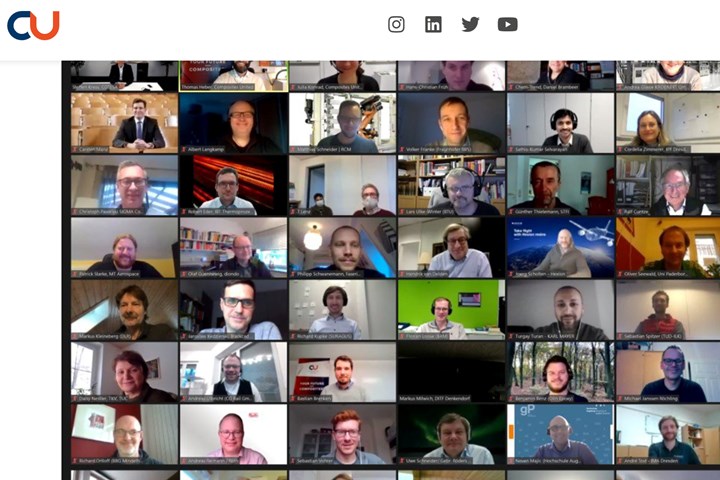Hydrogen theme day of Composites United e.V. is a big success
The European network’s “Hydrogen Storage — Opportunities for Fiber Composites” on Jan. 19, 2021 experienced more than 350 registrations.

Photo Credit: Composites United e.V.
- Event led by CU working group “Multi-Material-Design”
- Presentations discussed R&D for different tanks, materials and processes
- Participants asked for further exchange — to be hosted by CTC Stade on Nov. 18, 2021
More than 350 registrations were counted for the virtual theme day “Hydrogen Storage — Opportunities for Fiber Composites” from Composites United e.V. (CU) held on Jan. 19, 2021. Speakers and guests discussed in detail the possibilities of hydrogen storage and transport. A follow-up event has been announced for Nov. 18, 2021.
The EU wants to be climate-neutral by 2050 — that’s what its “Green Deal” agenda says. The energy transition is an important component in mastering the climate and environmental challenges and reducing emissions of the harmful greenhouse gas CO2. In addition to expanding renewable energies and increasing energy efficiency, alternative and non-fossil fuels will play an important role. Hydrogen is currently considered a promising energy carrier for the future.
The CU working group “Multi-Material-Design,” in cooperation with HZwo e.V. — Saxony Innovation Cluster for Fuel Cell and Hydrogen Technology, invited the industry to a theme day on Jan. 19, 2021. The question of what role lightweight design with fiber composites can play for storing and transporting hydrogen for mobile drive solutions was discussed with composite experts from the fields of engineering, manufacturing and testing.
The organizer and host Dr. Thomas Heber (Cluster Manager CU Ost and Head of the working group) and the virtual co-host Dr. Steffen Kress (CEO of COTESA GmbH) welcomed the speakers and guests to the Zoom conference and were very impressed by the high number of registrations and the corresponding interest. The presentations throughout the day showed how advanced and versatile the research and development activities already are in practice, highlighting in a material- and technology-neutral approach the benefits and disadvantages of different types of tanks, manufacturing processes and materials.
The experts agreed that fiber composites are the most important group of materials for tank systems of hydrogen-powered vehicles and aircraft. Composite pressure tanks are much lighter than metal designs and also have better mechanical properties. Whether hydrogen should be stored in a pressure vessel or a cryogenic tank depends on the specific application. Cryogenic tanks will be of particular interest for aviation in the future due to a better storage ratio in large tanks, while smaller pressure vessels are mainly used in the automotive industry. The potential for fiber composite lightweight design through peripheral components such as piping, structural connections, etc. was also discussed at the event.
Safety standards are a major technical challenge in the use of composites. For the tank as part of the drivetrain, it is important to identify risks and develop safety concepts for both operation and for crash situations. Burst and impact protection, fire safety, explosion protection and leak detection are at the top of the agenda. For comparable vehicle ranges, the use of hydrogen requires significantly larger tank volumes than fossil fuels; ideas for new overall vehicle concepts are needed.
At the end of the theme day, guests had the opportunity to accompany Dr. Steffen Kress on a virtual technology tour around the CORTESA plant in Mochau. Dr. Thomas Heber was pleased about the great interest in the event as well as the many contributions to the discussion, and summarizes: “For a future with lower emissions, it is of great importance to ensure and continuously develop technically faultless and thus safe technologies for the storage and transport of hydrogen. This requires reliable standards for quality, safety and operation — for economic success, the corresponding political and legal framework conditions are therefore also necessary.”
CU reports that during the event, many participants requested a further exchange on this topic and for a follow-up event. The organizers have responded directly to this request and announced the next theme day “Hydrogen Technology — Opportunity for Fiber Composites 2.0” for Nov. 18, 2021, to be hosted by the Composite Technology Center — CTC GmbH in Stade.
Related Content
Composites end markets: Batteries and fuel cells (2024)
As the number of battery and fuel cell electric vehicles (EVs) grows, so do the opportunities for composites in battery enclosures and components for fuel cells.
Read MoreMingYang reveals 18-MW offshore wind turbine model with 140-meter-long blades
The Chinese wind turbine manufacturer surpasses its 16-MW platform, optimizes wind farm construction costs for 1-GW wind farms.
Read MoreDrag-based wind turbine design for higher energy capture
Claiming significantly higher power generation capacity than traditional blades, Xenecore aims to scale up its current monocoque, fan-shaped wind blades, made via compression molded carbon fiber/epoxy with I-beam ribs and microsphere structural foam.
Read MoreECOHYDRO project to enable recyclable composites for hydrogen storage
With the involvement of two schools from the Institut Mines-Télécom, the 4-year project aims to improve the intrinsic properties of a composite material based on Elium via four concrete demonstrators.
Read MoreRead Next
“Structured air” TPS safeguards composite structures
Powered by an 85% air/15% pure polyimide aerogel, Blueshift’s novel material system protects structures during transient thermal events from -200°C to beyond 2400°C for rockets, battery boxes and more.
Read MoreVIDEO: High-volume processing for fiberglass components
Cannon Ergos, a company specializing in high-ton presses and equipment for composites fabrication and plastics processing, displayed automotive and industrial components at CAMX 2024.
Read MoreDeveloping bonded composite repair for ships, offshore units
Bureau Veritas and industry partners issue guidelines and pave the way for certification via StrengthBond Offshore project.
Read More















.jpg;maxWidth=300;quality=90)










